Corporate Accounting: Sources of Fund, Liabilities, and AASB 137
VerifiedAdded on 2023/01/13
|13
|3843
|56
AI Summary
This report discusses the different sources of funds used by selected organizations, the evolution of sources of funds over the years, the percentage of internally and externally generated funds, the merits and shortcomings of different sources, types of liabilities in the balance sheet, and key provisions under AASB 137.
Contribute Materials
Your contribution can guide someone’s learning journey. Share your
documents today.
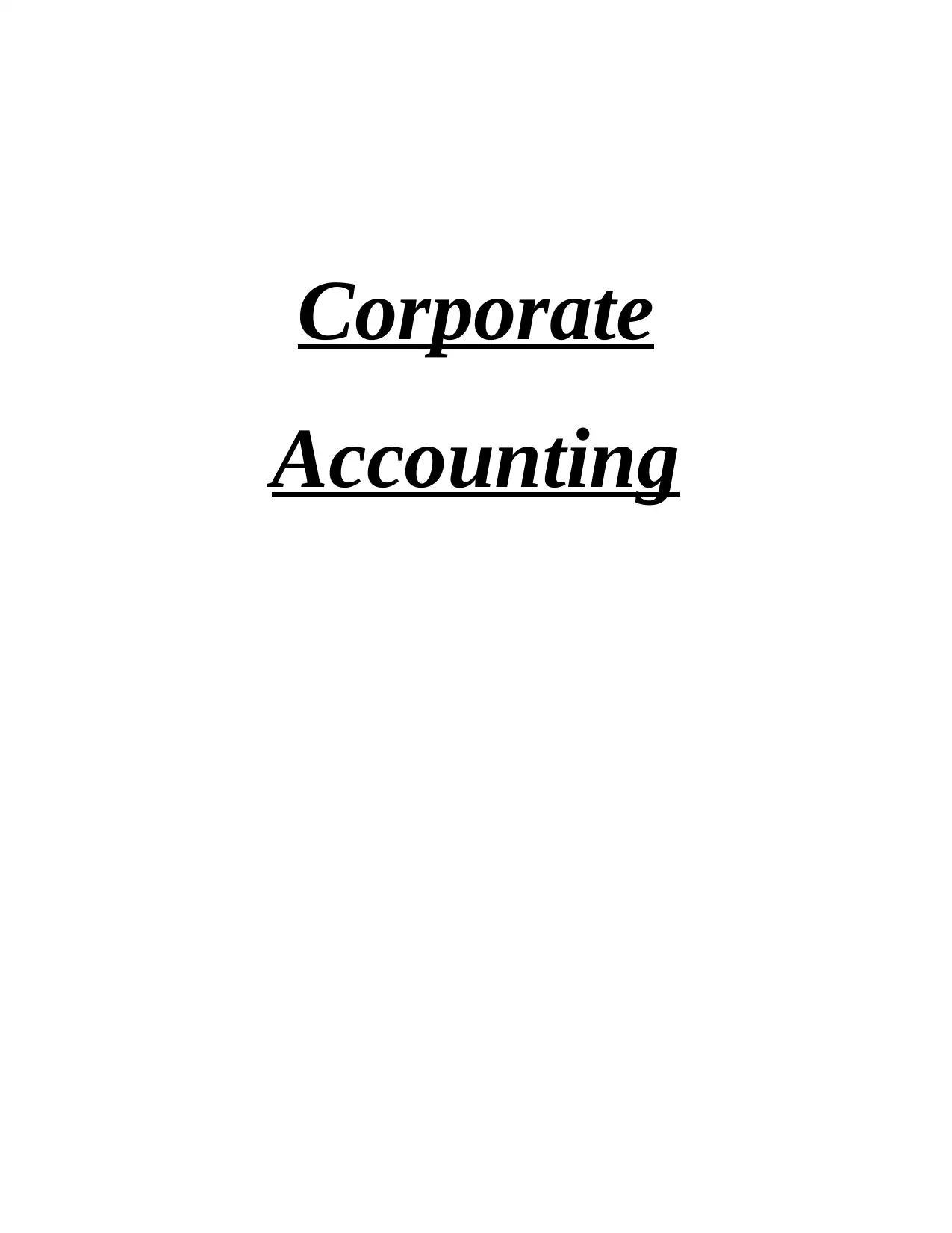
Corporate
Accounting
Accounting
Secure Best Marks with AI Grader
Need help grading? Try our AI Grader for instant feedback on your assignments.
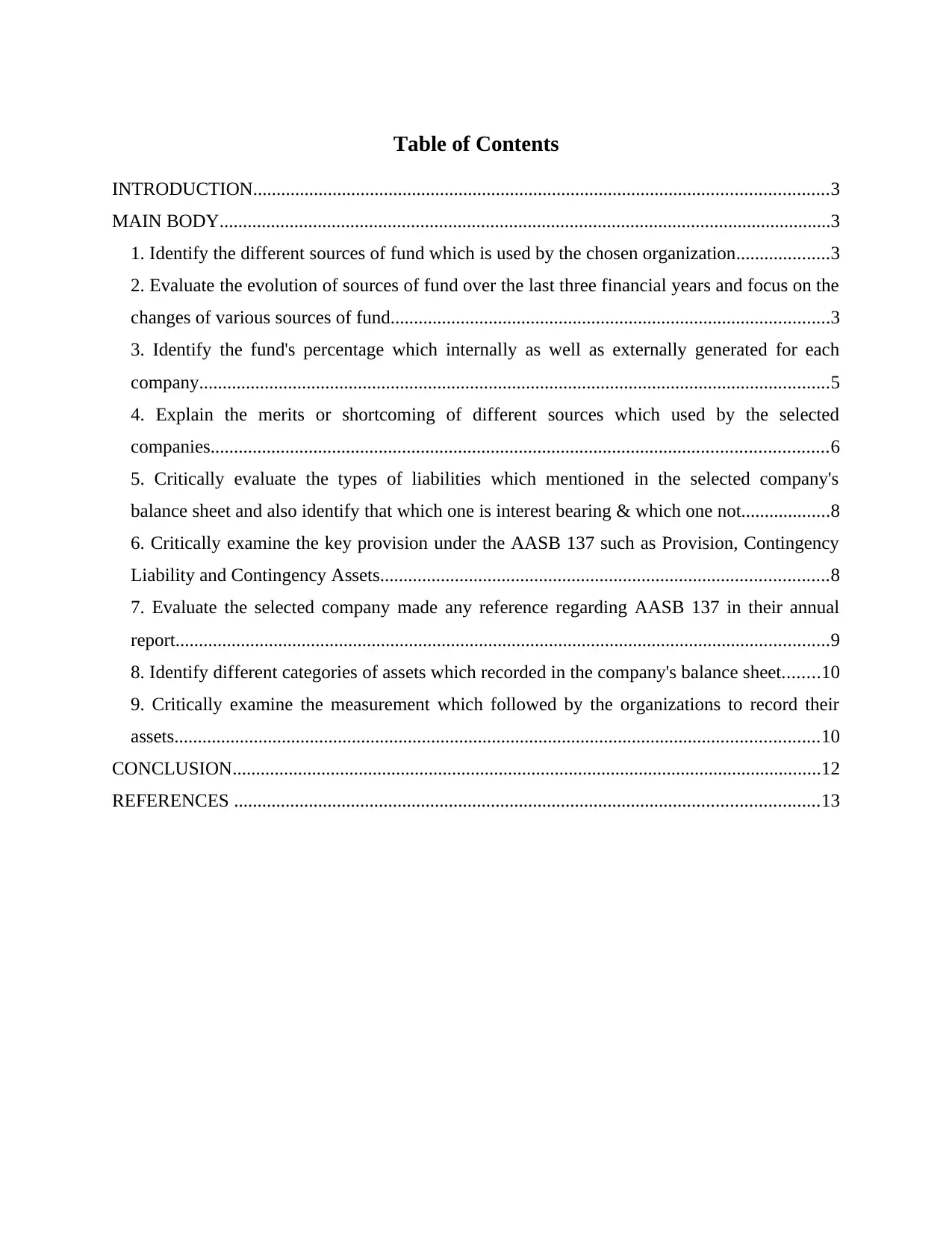
Table of Contents
INTRODUCTION...........................................................................................................................3
MAIN BODY...................................................................................................................................3
1. Identify the different sources of fund which is used by the chosen organization....................3
2. Evaluate the evolution of sources of fund over the last three financial years and focus on the
changes of various sources of fund..............................................................................................3
3. Identify the fund's percentage which internally as well as externally generated for each
company.......................................................................................................................................5
4. Explain the merits or shortcoming of different sources which used by the selected
companies....................................................................................................................................6
5. Critically evaluate the types of liabilities which mentioned in the selected company's
balance sheet and also identify that which one is interest bearing & which one not...................8
6. Critically examine the key provision under the AASB 137 such as Provision, Contingency
Liability and Contingency Assets................................................................................................8
7. Evaluate the selected company made any reference regarding AASB 137 in their annual
report............................................................................................................................................9
8. Identify different categories of assets which recorded in the company's balance sheet........10
9. Critically examine the measurement which followed by the organizations to record their
assets..........................................................................................................................................10
CONCLUSION..............................................................................................................................12
REFERENCES .............................................................................................................................13
INTRODUCTION...........................................................................................................................3
MAIN BODY...................................................................................................................................3
1. Identify the different sources of fund which is used by the chosen organization....................3
2. Evaluate the evolution of sources of fund over the last three financial years and focus on the
changes of various sources of fund..............................................................................................3
3. Identify the fund's percentage which internally as well as externally generated for each
company.......................................................................................................................................5
4. Explain the merits or shortcoming of different sources which used by the selected
companies....................................................................................................................................6
5. Critically evaluate the types of liabilities which mentioned in the selected company's
balance sheet and also identify that which one is interest bearing & which one not...................8
6. Critically examine the key provision under the AASB 137 such as Provision, Contingency
Liability and Contingency Assets................................................................................................8
7. Evaluate the selected company made any reference regarding AASB 137 in their annual
report............................................................................................................................................9
8. Identify different categories of assets which recorded in the company's balance sheet........10
9. Critically examine the measurement which followed by the organizations to record their
assets..........................................................................................................................................10
CONCLUSION..............................................................................................................................12
REFERENCES .............................................................................................................................13
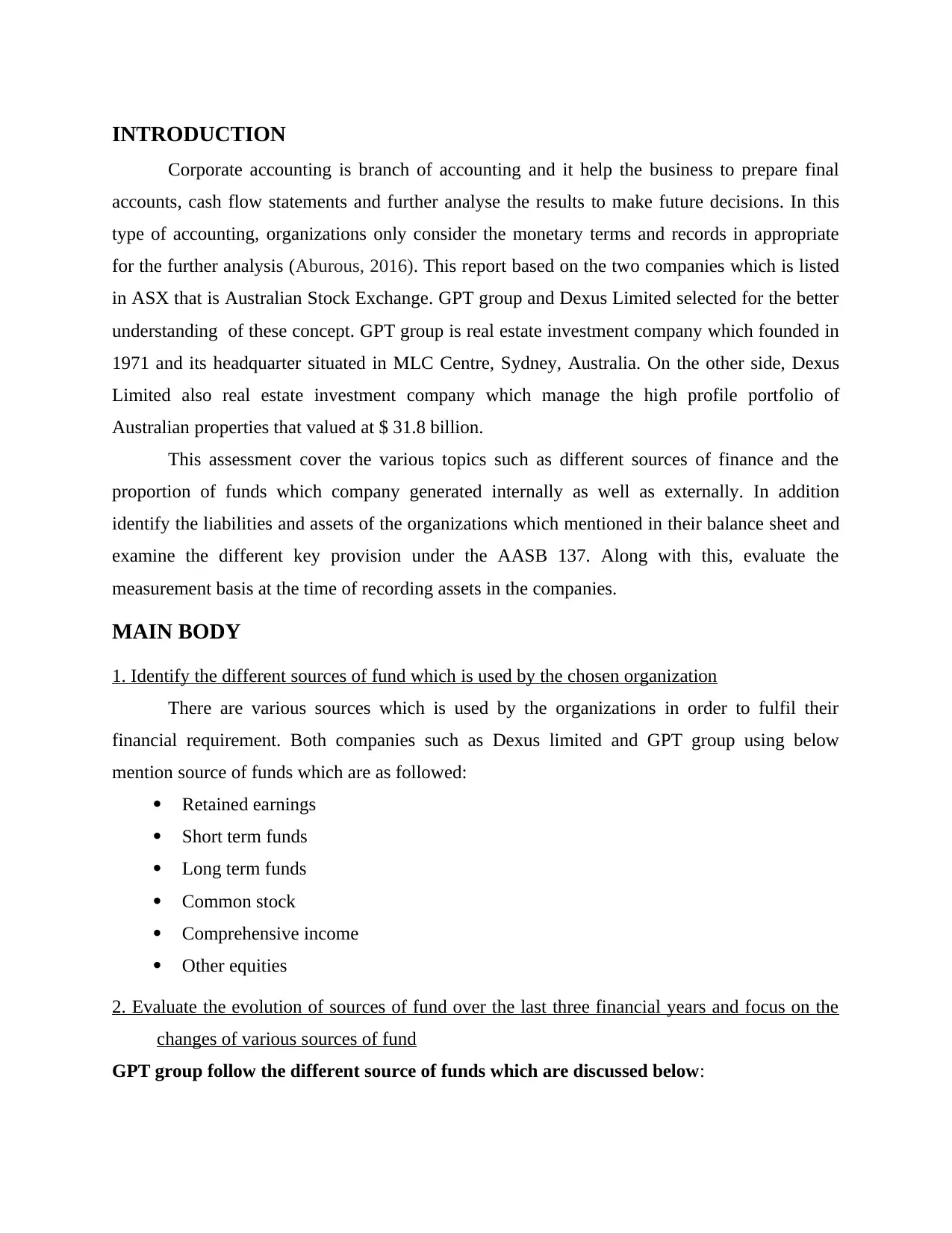
INTRODUCTION
Corporate accounting is branch of accounting and it help the business to prepare final
accounts, cash flow statements and further analyse the results to make future decisions. In this
type of accounting, organizations only consider the monetary terms and records in appropriate
for the further analysis (Aburous, 2016). This report based on the two companies which is listed
in ASX that is Australian Stock Exchange. GPT group and Dexus Limited selected for the better
understanding of these concept. GPT group is real estate investment company which founded in
1971 and its headquarter situated in MLC Centre, Sydney, Australia. On the other side, Dexus
Limited also real estate investment company which manage the high profile portfolio of
Australian properties that valued at $ 31.8 billion.
This assessment cover the various topics such as different sources of finance and the
proportion of funds which company generated internally as well as externally. In addition
identify the liabilities and assets of the organizations which mentioned in their balance sheet and
examine the different key provision under the AASB 137. Along with this, evaluate the
measurement basis at the time of recording assets in the companies.
MAIN BODY
1. Identify the different sources of fund which is used by the chosen organization
There are various sources which is used by the organizations in order to fulfil their
financial requirement. Both companies such as Dexus limited and GPT group using below
mention source of funds which are as followed:
Retained earnings
Short term funds
Long term funds
Common stock
Comprehensive income
Other equities
2. Evaluate the evolution of sources of fund over the last three financial years and focus on the
changes of various sources of fund
GPT group follow the different source of funds which are discussed below:
Corporate accounting is branch of accounting and it help the business to prepare final
accounts, cash flow statements and further analyse the results to make future decisions. In this
type of accounting, organizations only consider the monetary terms and records in appropriate
for the further analysis (Aburous, 2016). This report based on the two companies which is listed
in ASX that is Australian Stock Exchange. GPT group and Dexus Limited selected for the better
understanding of these concept. GPT group is real estate investment company which founded in
1971 and its headquarter situated in MLC Centre, Sydney, Australia. On the other side, Dexus
Limited also real estate investment company which manage the high profile portfolio of
Australian properties that valued at $ 31.8 billion.
This assessment cover the various topics such as different sources of finance and the
proportion of funds which company generated internally as well as externally. In addition
identify the liabilities and assets of the organizations which mentioned in their balance sheet and
examine the different key provision under the AASB 137. Along with this, evaluate the
measurement basis at the time of recording assets in the companies.
MAIN BODY
1. Identify the different sources of fund which is used by the chosen organization
There are various sources which is used by the organizations in order to fulfil their
financial requirement. Both companies such as Dexus limited and GPT group using below
mention source of funds which are as followed:
Retained earnings
Short term funds
Long term funds
Common stock
Comprehensive income
Other equities
2. Evaluate the evolution of sources of fund over the last three financial years and focus on the
changes of various sources of fund
GPT group follow the different source of funds which are discussed below:

Short term funds: Company required short terms debt which they had to repay within
one year and with the help of it GPT group able to perform their daily basis activities or fulfil the
financial requirements (Agrawal and Cooper, 2017). In 2018 company required around $ 20
million and in the previous years they were $ 49 million in both 2017 or 2016. it is observed that
company reduces their short term debt around $ 29 million.
Long term funds: Company required long term debt to make necessary changes in the
business operations or maximise the productivity. GOT group had long term debt in 2016 was
around $ 2948 million, in 2017 it was $ 3281 million and in 2018 it was $ 3599 million
(Financial report of GPT Group, 2020). It is clearly mentioned that, company required more
finance to perform their operations because long term debt increases every year.
Retain earnings: This earning secure by the company to for the future purpose or any
uninvited event. In 2016, GPT retain around $ 124 million, $ 950 million or $ 1945 million in
2017 or 2018 respectively. It is analysed that company raise their earning for for the further
actions which is beneficial for the company.
Common stock: With the help of company's balance sheet, it is observed that GPT has $
8130 million of common stock 2016, $ 8141 million in 2017 and in 2018 it was around $ 8152
million stock. There is not enough difference in the common stock in different period.
Comprehensive income: In the GPT Group, balance sheet shows that company had
other income around $ 16 million in 2016. In 2017, it was $ 9 million and ($ 8 million) in 2018
that was loss for the company.
Other equity: With the help of balance sheet of the company, it is observed that GPT
Group has $ 13 millions of other equities in 2016 (Atanasov and Black, 2016). In 2017, it was $
8 million and $ 13 million in 2018. There is a fluctuation in the other equities due to requirement
of liquidity in the organizations.
Dexus limited using below mention source of funds to fulfil their financial requirements:
Short term funds: Company was taken short term loan in 2016 around $ 316 million, $
149 million in 2017 and in 2018 it was $ 205 million. It has been analysed that Dexus limited
borrow different amount of loan in the different years.
Long term funds: With the help of financial statement of the company it is observed that
Dexus had long term debt around $ 3371 million in 2016. On the other side, it was reduces in
one year and with the help of it GPT group able to perform their daily basis activities or fulfil the
financial requirements (Agrawal and Cooper, 2017). In 2018 company required around $ 20
million and in the previous years they were $ 49 million in both 2017 or 2016. it is observed that
company reduces their short term debt around $ 29 million.
Long term funds: Company required long term debt to make necessary changes in the
business operations or maximise the productivity. GOT group had long term debt in 2016 was
around $ 2948 million, in 2017 it was $ 3281 million and in 2018 it was $ 3599 million
(Financial report of GPT Group, 2020). It is clearly mentioned that, company required more
finance to perform their operations because long term debt increases every year.
Retain earnings: This earning secure by the company to for the future purpose or any
uninvited event. In 2016, GPT retain around $ 124 million, $ 950 million or $ 1945 million in
2017 or 2018 respectively. It is analysed that company raise their earning for for the further
actions which is beneficial for the company.
Common stock: With the help of company's balance sheet, it is observed that GPT has $
8130 million of common stock 2016, $ 8141 million in 2017 and in 2018 it was around $ 8152
million stock. There is not enough difference in the common stock in different period.
Comprehensive income: In the GPT Group, balance sheet shows that company had
other income around $ 16 million in 2016. In 2017, it was $ 9 million and ($ 8 million) in 2018
that was loss for the company.
Other equity: With the help of balance sheet of the company, it is observed that GPT
Group has $ 13 millions of other equities in 2016 (Atanasov and Black, 2016). In 2017, it was $
8 million and $ 13 million in 2018. There is a fluctuation in the other equities due to requirement
of liquidity in the organizations.
Dexus limited using below mention source of funds to fulfil their financial requirements:
Short term funds: Company was taken short term loan in 2016 around $ 316 million, $
149 million in 2017 and in 2018 it was $ 205 million. It has been analysed that Dexus limited
borrow different amount of loan in the different years.
Long term funds: With the help of financial statement of the company it is observed that
Dexus had long term debt around $ 3371 million in 2016. On the other side, it was reduces in
Secure Best Marks with AI Grader
Need help grading? Try our AI Grader for instant feedback on your assignments.

2017 and remain $ 2698 million and again increases in 2018, it was around $ 3155 million. It is
analysed that company depend on long term debts which increases yearly.
Retain earnings: It is analysed that financial performance of company in terms of retain
earning was $ 1634 million in 2016 and in 2017 it was around $ 2373 million. In 2018, it was $
3616 million which continues increases (Financial report of Dexus Limited, 2020). It indicates
that company has strong financial position in the market because of high value of their retain
earning in every year.
Common stock: In the Dexus limited, there are some common stocks such as in 2016 it
was $ 5910 million, in 2017 it was around $ 6402 million and in 2018, it was $ 6404 million. It is
observed that organizations increases their stock level through issuing funds.
Comprehensive income: In Dexus Limited, comprehensive income or loss mentioned in
the balance sheet and it is settled with the retain earning (Bedford and Ziegler, 2016). In 2016, it
was $ 43 million and in the next two years it was constant that is 2017 or 2018. Company does
not gain but not occur loss for the same.
Other equity: Equity is the essential source of fund which is used by the organizations
and in Dexus Limited its value around $ 9 million in the period of 2016. After that it became
negative and having loss around $ 16 million in 2018.
3. Identify the fund's percentage which internally as well as externally generated for each
company
Both organizations such as Dexus Limited or GPT Group arrange funds from internal as
well as external sources. They also contributed in some proportion which mentioned in the table.
Dexus Limited:
Funds generated from internal sources Percentage of Funds
Sales of assets 10%
Issue equities 3% of equity
Loan from partners 5%
Insurance recovery 5%
Funds generated from external sources Percentage of Funds
analysed that company depend on long term debts which increases yearly.
Retain earnings: It is analysed that financial performance of company in terms of retain
earning was $ 1634 million in 2016 and in 2017 it was around $ 2373 million. In 2018, it was $
3616 million which continues increases (Financial report of Dexus Limited, 2020). It indicates
that company has strong financial position in the market because of high value of their retain
earning in every year.
Common stock: In the Dexus limited, there are some common stocks such as in 2016 it
was $ 5910 million, in 2017 it was around $ 6402 million and in 2018, it was $ 6404 million. It is
observed that organizations increases their stock level through issuing funds.
Comprehensive income: In Dexus Limited, comprehensive income or loss mentioned in
the balance sheet and it is settled with the retain earning (Bedford and Ziegler, 2016). In 2016, it
was $ 43 million and in the next two years it was constant that is 2017 or 2018. Company does
not gain but not occur loss for the same.
Other equity: Equity is the essential source of fund which is used by the organizations
and in Dexus Limited its value around $ 9 million in the period of 2016. After that it became
negative and having loss around $ 16 million in 2018.
3. Identify the fund's percentage which internally as well as externally generated for each
company
Both organizations such as Dexus Limited or GPT Group arrange funds from internal as
well as external sources. They also contributed in some proportion which mentioned in the table.
Dexus Limited:
Funds generated from internal sources Percentage of Funds
Sales of assets 10%
Issue equities 3% of equity
Loan from partners 5%
Insurance recovery 5%
Funds generated from external sources Percentage of Funds
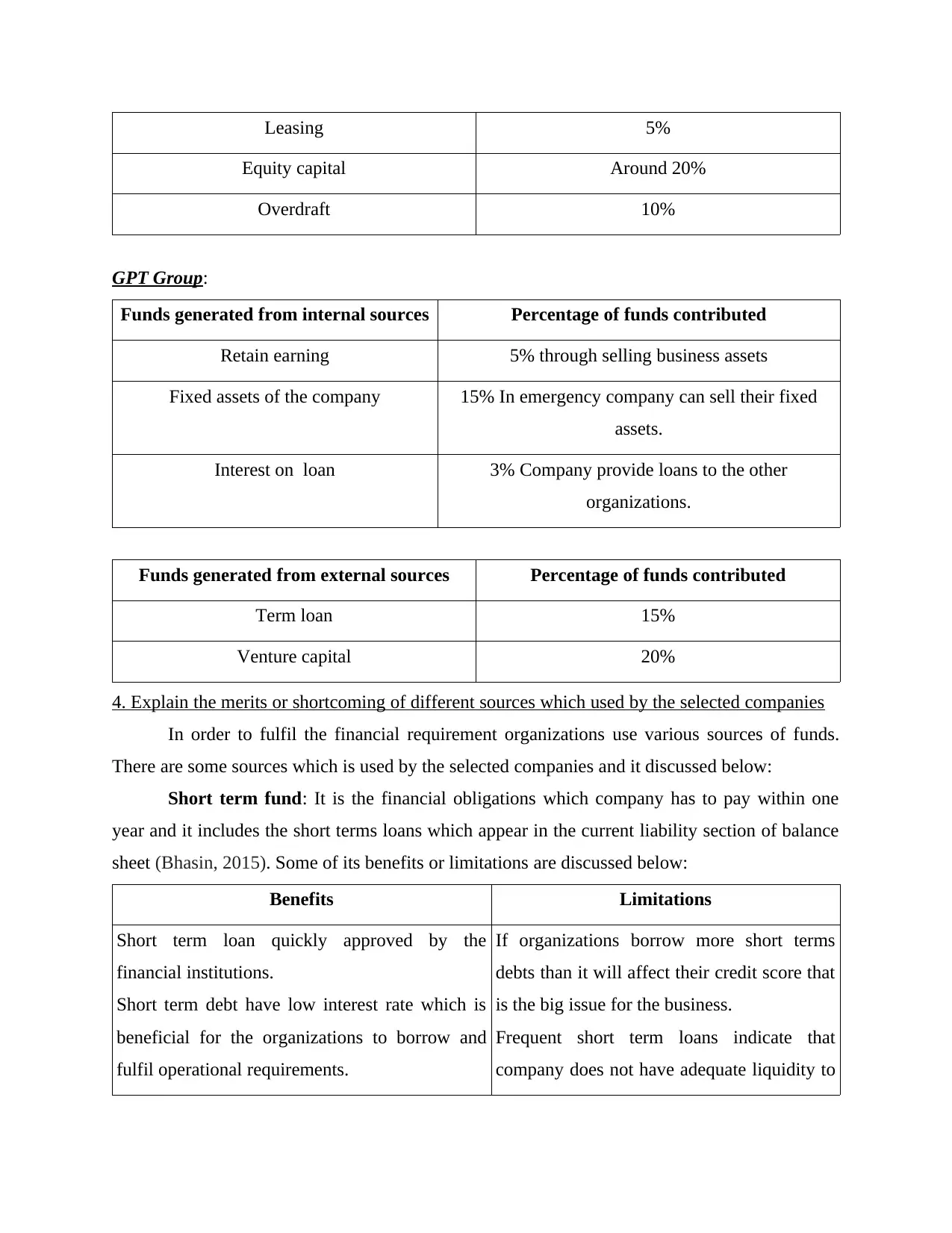
Leasing 5%
Equity capital Around 20%
Overdraft 10%
GPT Group:
Funds generated from internal sources Percentage of funds contributed
Retain earning 5% through selling business assets
Fixed assets of the company 15% In emergency company can sell their fixed
assets.
Interest on loan 3% Company provide loans to the other
organizations.
Funds generated from external sources Percentage of funds contributed
Term loan 15%
Venture capital 20%
4. Explain the merits or shortcoming of different sources which used by the selected companies
In order to fulfil the financial requirement organizations use various sources of funds.
There are some sources which is used by the selected companies and it discussed below:
Short term fund: It is the financial obligations which company has to pay within one
year and it includes the short terms loans which appear in the current liability section of balance
sheet (Bhasin, 2015). Some of its benefits or limitations are discussed below:
Benefits Limitations
Short term loan quickly approved by the
financial institutions.
Short term debt have low interest rate which is
beneficial for the organizations to borrow and
fulfil operational requirements.
If organizations borrow more short terms
debts than it will affect their credit score that
is the big issue for the business.
Frequent short term loans indicate that
company does not have adequate liquidity to
Equity capital Around 20%
Overdraft 10%
GPT Group:
Funds generated from internal sources Percentage of funds contributed
Retain earning 5% through selling business assets
Fixed assets of the company 15% In emergency company can sell their fixed
assets.
Interest on loan 3% Company provide loans to the other
organizations.
Funds generated from external sources Percentage of funds contributed
Term loan 15%
Venture capital 20%
4. Explain the merits or shortcoming of different sources which used by the selected companies
In order to fulfil the financial requirement organizations use various sources of funds.
There are some sources which is used by the selected companies and it discussed below:
Short term fund: It is the financial obligations which company has to pay within one
year and it includes the short terms loans which appear in the current liability section of balance
sheet (Bhasin, 2015). Some of its benefits or limitations are discussed below:
Benefits Limitations
Short term loan quickly approved by the
financial institutions.
Short term debt have low interest rate which is
beneficial for the organizations to borrow and
fulfil operational requirements.
If organizations borrow more short terms
debts than it will affect their credit score that
is the big issue for the business.
Frequent short term loans indicate that
company does not have adequate liquidity to
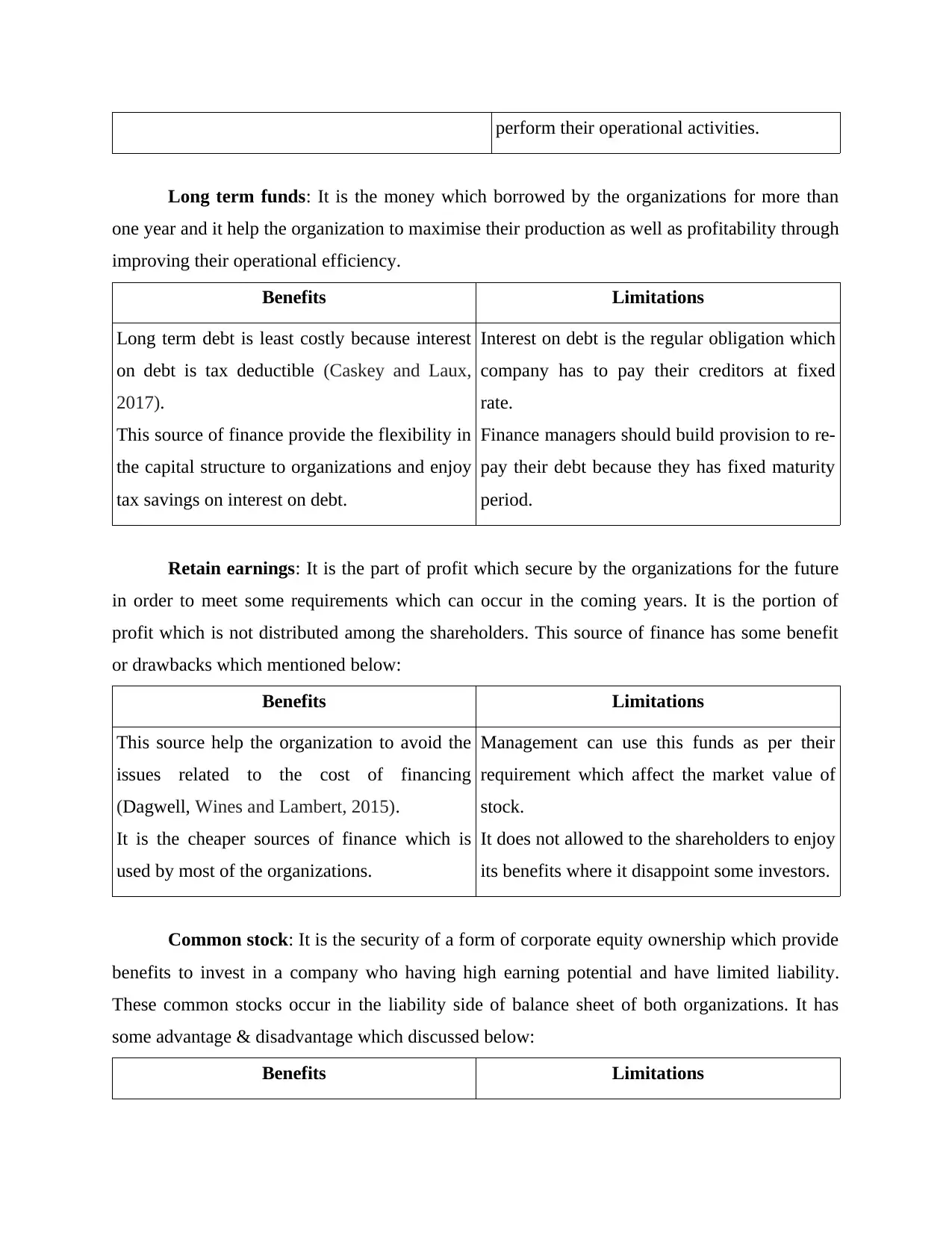
perform their operational activities.
Long term funds: It is the money which borrowed by the organizations for more than
one year and it help the organization to maximise their production as well as profitability through
improving their operational efficiency.
Benefits Limitations
Long term debt is least costly because interest
on debt is tax deductible (Caskey and Laux,
2017).
This source of finance provide the flexibility in
the capital structure to organizations and enjoy
tax savings on interest on debt.
Interest on debt is the regular obligation which
company has to pay their creditors at fixed
rate.
Finance managers should build provision to re-
pay their debt because they has fixed maturity
period.
Retain earnings: It is the part of profit which secure by the organizations for the future
in order to meet some requirements which can occur in the coming years. It is the portion of
profit which is not distributed among the shareholders. This source of finance has some benefit
or drawbacks which mentioned below:
Benefits Limitations
This source help the organization to avoid the
issues related to the cost of financing
(Dagwell, Wines and Lambert, 2015).
It is the cheaper sources of finance which is
used by most of the organizations.
Management can use this funds as per their
requirement which affect the market value of
stock.
It does not allowed to the shareholders to enjoy
its benefits where it disappoint some investors.
Common stock: It is the security of a form of corporate equity ownership which provide
benefits to invest in a company who having high earning potential and have limited liability.
These common stocks occur in the liability side of balance sheet of both organizations. It has
some advantage & disadvantage which discussed below:
Benefits Limitations
Long term funds: It is the money which borrowed by the organizations for more than
one year and it help the organization to maximise their production as well as profitability through
improving their operational efficiency.
Benefits Limitations
Long term debt is least costly because interest
on debt is tax deductible (Caskey and Laux,
2017).
This source of finance provide the flexibility in
the capital structure to organizations and enjoy
tax savings on interest on debt.
Interest on debt is the regular obligation which
company has to pay their creditors at fixed
rate.
Finance managers should build provision to re-
pay their debt because they has fixed maturity
period.
Retain earnings: It is the part of profit which secure by the organizations for the future
in order to meet some requirements which can occur in the coming years. It is the portion of
profit which is not distributed among the shareholders. This source of finance has some benefit
or drawbacks which mentioned below:
Benefits Limitations
This source help the organization to avoid the
issues related to the cost of financing
(Dagwell, Wines and Lambert, 2015).
It is the cheaper sources of finance which is
used by most of the organizations.
Management can use this funds as per their
requirement which affect the market value of
stock.
It does not allowed to the shareholders to enjoy
its benefits where it disappoint some investors.
Common stock: It is the security of a form of corporate equity ownership which provide
benefits to invest in a company who having high earning potential and have limited liability.
These common stocks occur in the liability side of balance sheet of both organizations. It has
some advantage & disadvantage which discussed below:
Benefits Limitations
Paraphrase This Document
Need a fresh take? Get an instant paraphrase of this document with our AI Paraphraser
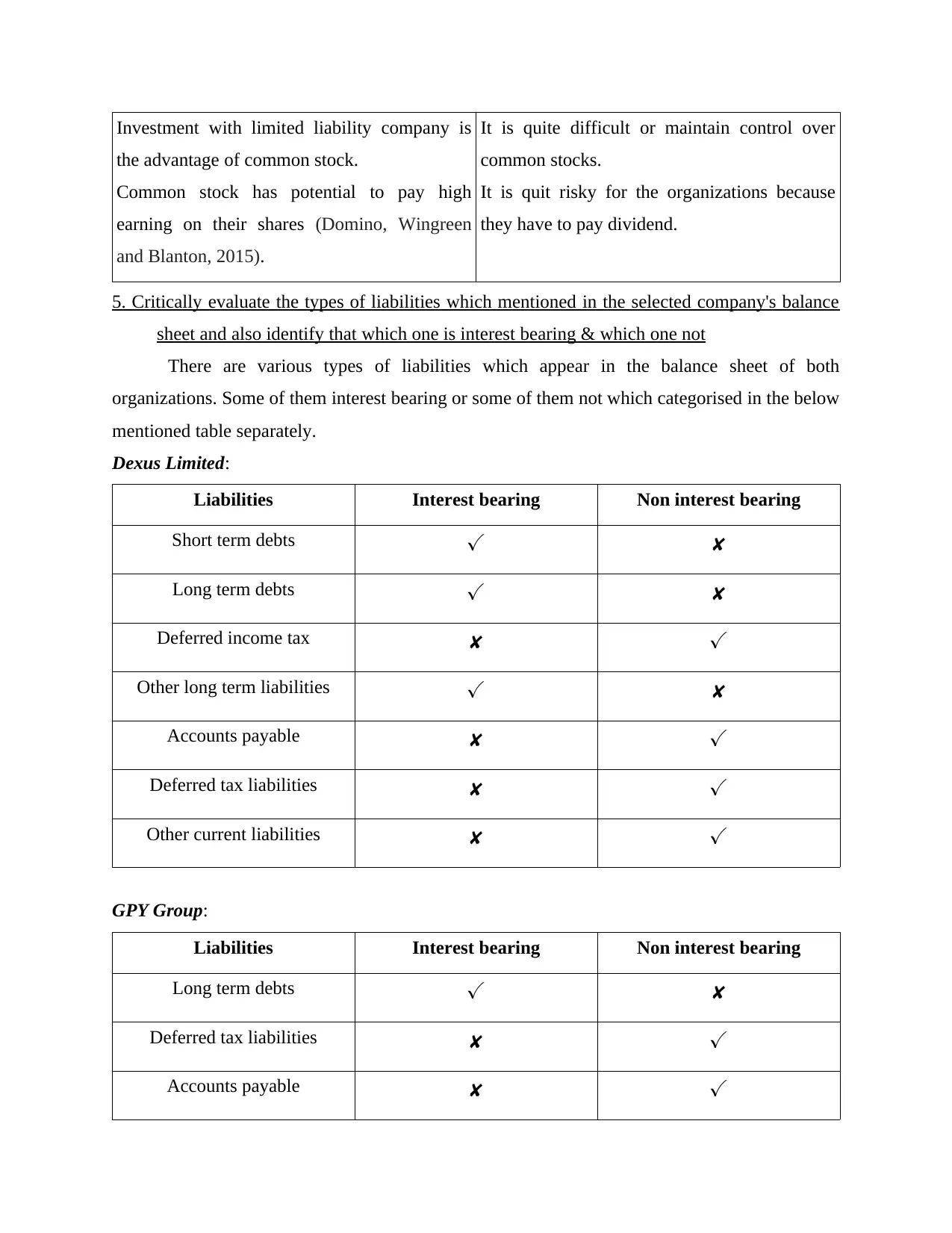
Investment with limited liability company is
the advantage of common stock.
Common stock has potential to pay high
earning on their shares (Domino, Wingreen
and Blanton, 2015).
It is quite difficult or maintain control over
common stocks.
It is quit risky for the organizations because
they have to pay dividend.
5. Critically evaluate the types of liabilities which mentioned in the selected company's balance
sheet and also identify that which one is interest bearing & which one not
There are various types of liabilities which appear in the balance sheet of both
organizations. Some of them interest bearing or some of them not which categorised in the below
mentioned table separately.
Dexus Limited:
Liabilities Interest bearing Non interest bearing
Short term debts ✓ ✘
Long term debts ✓ ✘
Deferred income tax ✘ ✓
Other long term liabilities ✓ ✘
Accounts payable ✘ ✓
Deferred tax liabilities ✘ ✓
Other current liabilities ✘ ✓
GPY Group:
Liabilities Interest bearing Non interest bearing
Long term debts ✓ ✘
Deferred tax liabilities ✘ ✓
Accounts payable ✘ ✓
the advantage of common stock.
Common stock has potential to pay high
earning on their shares (Domino, Wingreen
and Blanton, 2015).
It is quite difficult or maintain control over
common stocks.
It is quit risky for the organizations because
they have to pay dividend.
5. Critically evaluate the types of liabilities which mentioned in the selected company's balance
sheet and also identify that which one is interest bearing & which one not
There are various types of liabilities which appear in the balance sheet of both
organizations. Some of them interest bearing or some of them not which categorised in the below
mentioned table separately.
Dexus Limited:
Liabilities Interest bearing Non interest bearing
Short term debts ✓ ✘
Long term debts ✓ ✘
Deferred income tax ✘ ✓
Other long term liabilities ✓ ✘
Accounts payable ✘ ✓
Deferred tax liabilities ✘ ✓
Other current liabilities ✘ ✓
GPY Group:
Liabilities Interest bearing Non interest bearing
Long term debts ✓ ✘
Deferred tax liabilities ✘ ✓
Accounts payable ✘ ✓
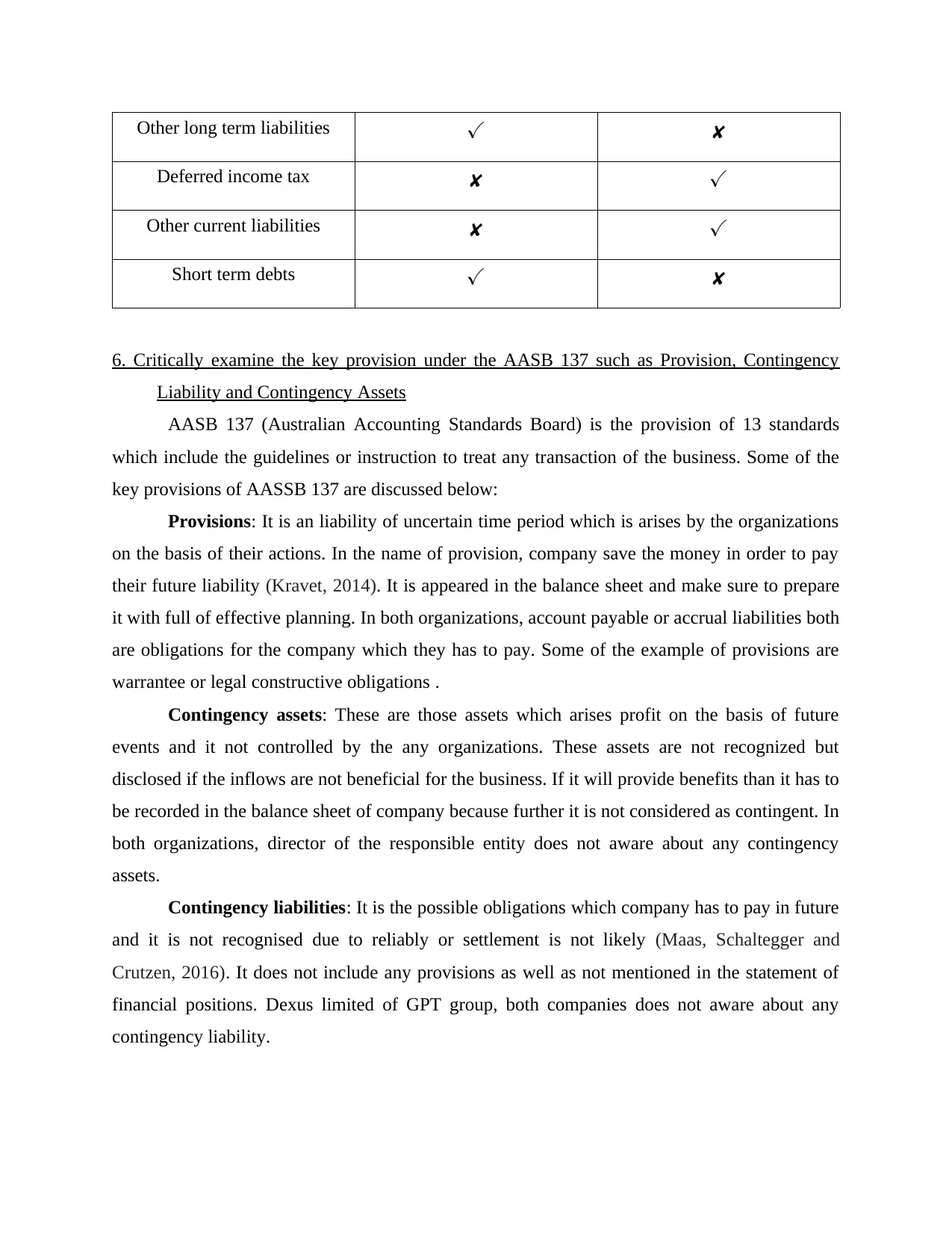
Other long term liabilities ✓ ✘
Deferred income tax ✘ ✓
Other current liabilities ✘ ✓
Short term debts ✓ ✘
6. Critically examine the key provision under the AASB 137 such as Provision, Contingency
Liability and Contingency Assets
AASB 137 (Australian Accounting Standards Board) is the provision of 13 standards
which include the guidelines or instruction to treat any transaction of the business. Some of the
key provisions of AASSB 137 are discussed below:
Provisions: It is an liability of uncertain time period which is arises by the organizations
on the basis of their actions. In the name of provision, company save the money in order to pay
their future liability (Kravet, 2014). It is appeared in the balance sheet and make sure to prepare
it with full of effective planning. In both organizations, account payable or accrual liabilities both
are obligations for the company which they has to pay. Some of the example of provisions are
warrantee or legal constructive obligations .
Contingency assets: These are those assets which arises profit on the basis of future
events and it not controlled by the any organizations. These assets are not recognized but
disclosed if the inflows are not beneficial for the business. If it will provide benefits than it has to
be recorded in the balance sheet of company because further it is not considered as contingent. In
both organizations, director of the responsible entity does not aware about any contingency
assets.
Contingency liabilities: It is the possible obligations which company has to pay in future
and it is not recognised due to reliably or settlement is not likely (Maas, Schaltegger and
Crutzen, 2016). It does not include any provisions as well as not mentioned in the statement of
financial positions. Dexus limited of GPT group, both companies does not aware about any
contingency liability.
Deferred income tax ✘ ✓
Other current liabilities ✘ ✓
Short term debts ✓ ✘
6. Critically examine the key provision under the AASB 137 such as Provision, Contingency
Liability and Contingency Assets
AASB 137 (Australian Accounting Standards Board) is the provision of 13 standards
which include the guidelines or instruction to treat any transaction of the business. Some of the
key provisions of AASSB 137 are discussed below:
Provisions: It is an liability of uncertain time period which is arises by the organizations
on the basis of their actions. In the name of provision, company save the money in order to pay
their future liability (Kravet, 2014). It is appeared in the balance sheet and make sure to prepare
it with full of effective planning. In both organizations, account payable or accrual liabilities both
are obligations for the company which they has to pay. Some of the example of provisions are
warrantee or legal constructive obligations .
Contingency assets: These are those assets which arises profit on the basis of future
events and it not controlled by the any organizations. These assets are not recognized but
disclosed if the inflows are not beneficial for the business. If it will provide benefits than it has to
be recorded in the balance sheet of company because further it is not considered as contingent. In
both organizations, director of the responsible entity does not aware about any contingency
assets.
Contingency liabilities: It is the possible obligations which company has to pay in future
and it is not recognised due to reliably or settlement is not likely (Maas, Schaltegger and
Crutzen, 2016). It does not include any provisions as well as not mentioned in the statement of
financial positions. Dexus limited of GPT group, both companies does not aware about any
contingency liability.
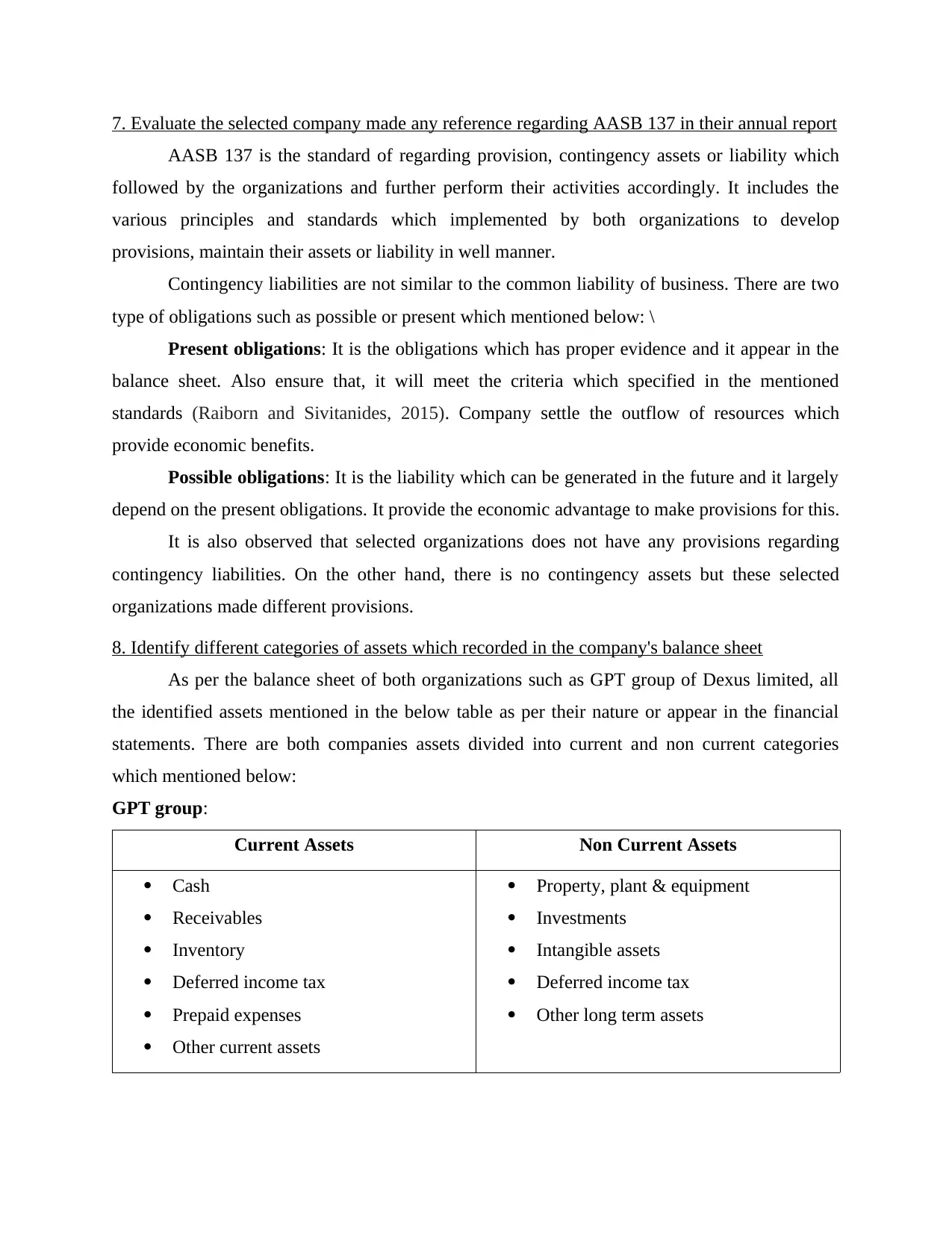
7. Evaluate the selected company made any reference regarding AASB 137 in their annual report
AASB 137 is the standard of regarding provision, contingency assets or liability which
followed by the organizations and further perform their activities accordingly. It includes the
various principles and standards which implemented by both organizations to develop
provisions, maintain their assets or liability in well manner.
Contingency liabilities are not similar to the common liability of business. There are two
type of obligations such as possible or present which mentioned below: \
Present obligations: It is the obligations which has proper evidence and it appear in the
balance sheet. Also ensure that, it will meet the criteria which specified in the mentioned
standards (Raiborn and Sivitanides, 2015). Company settle the outflow of resources which
provide economic benefits.
Possible obligations: It is the liability which can be generated in the future and it largely
depend on the present obligations. It provide the economic advantage to make provisions for this.
It is also observed that selected organizations does not have any provisions regarding
contingency liabilities. On the other hand, there is no contingency assets but these selected
organizations made different provisions.
8. Identify different categories of assets which recorded in the company's balance sheet
As per the balance sheet of both organizations such as GPT group of Dexus limited, all
the identified assets mentioned in the below table as per their nature or appear in the financial
statements. There are both companies assets divided into current and non current categories
which mentioned below:
GPT group:
Current Assets Non Current Assets
Cash
Receivables
Inventory
Deferred income tax
Prepaid expenses
Other current assets
Property, plant & equipment
Investments
Intangible assets
Deferred income tax
Other long term assets
AASB 137 is the standard of regarding provision, contingency assets or liability which
followed by the organizations and further perform their activities accordingly. It includes the
various principles and standards which implemented by both organizations to develop
provisions, maintain their assets or liability in well manner.
Contingency liabilities are not similar to the common liability of business. There are two
type of obligations such as possible or present which mentioned below: \
Present obligations: It is the obligations which has proper evidence and it appear in the
balance sheet. Also ensure that, it will meet the criteria which specified in the mentioned
standards (Raiborn and Sivitanides, 2015). Company settle the outflow of resources which
provide economic benefits.
Possible obligations: It is the liability which can be generated in the future and it largely
depend on the present obligations. It provide the economic advantage to make provisions for this.
It is also observed that selected organizations does not have any provisions regarding
contingency liabilities. On the other hand, there is no contingency assets but these selected
organizations made different provisions.
8. Identify different categories of assets which recorded in the company's balance sheet
As per the balance sheet of both organizations such as GPT group of Dexus limited, all
the identified assets mentioned in the below table as per their nature or appear in the financial
statements. There are both companies assets divided into current and non current categories
which mentioned below:
GPT group:
Current Assets Non Current Assets
Cash
Receivables
Inventory
Deferred income tax
Prepaid expenses
Other current assets
Property, plant & equipment
Investments
Intangible assets
Deferred income tax
Other long term assets
Secure Best Marks with AI Grader
Need help grading? Try our AI Grader for instant feedback on your assignments.
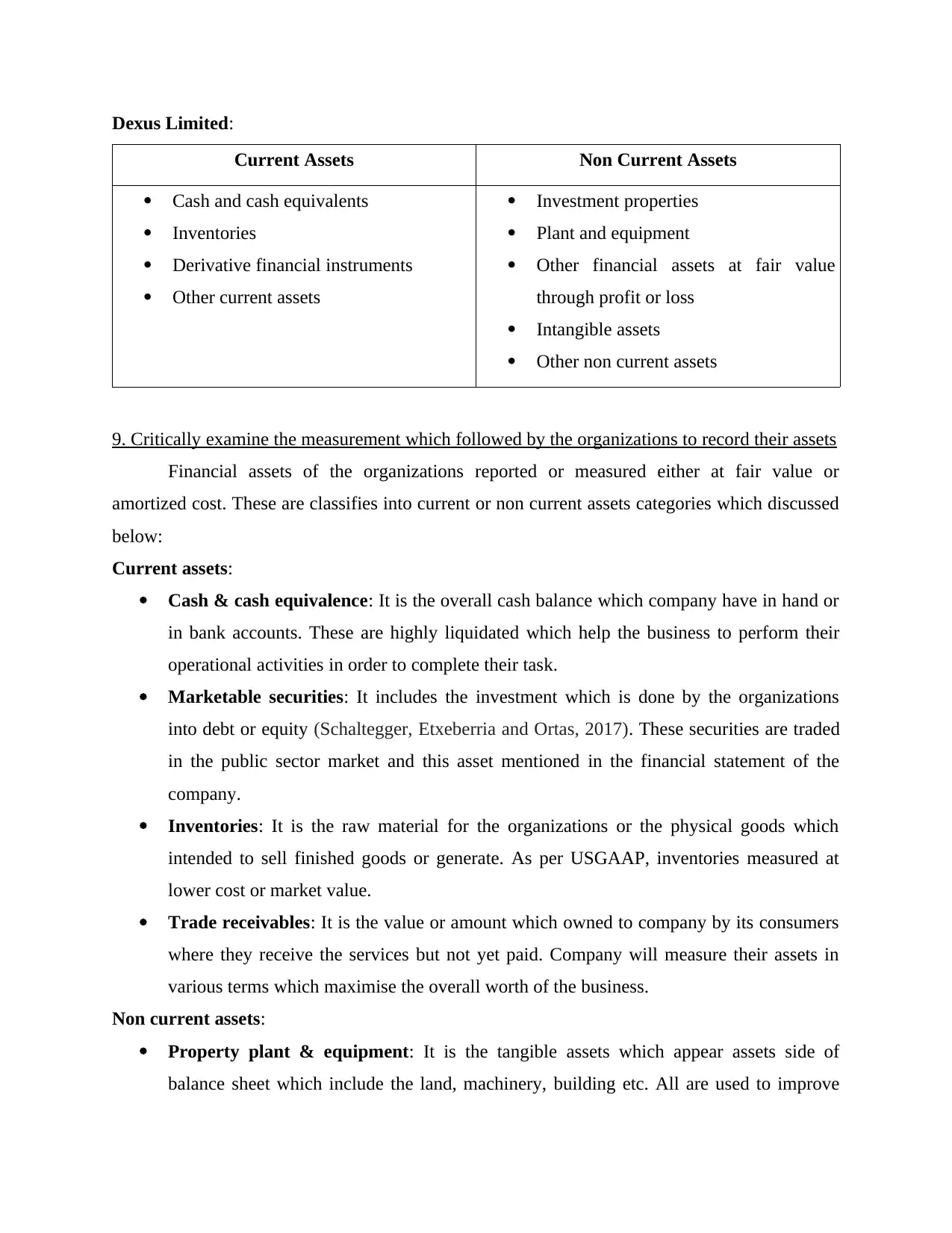
Dexus Limited:
Current Assets Non Current Assets
Cash and cash equivalents
Inventories
Derivative financial instruments
Other current assets
Investment properties
Plant and equipment
Other financial assets at fair value
through profit or loss
Intangible assets
Other non current assets
9. Critically examine the measurement which followed by the organizations to record their assets
Financial assets of the organizations reported or measured either at fair value or
amortized cost. These are classifies into current or non current assets categories which discussed
below:
Current assets:
Cash & cash equivalence: It is the overall cash balance which company have in hand or
in bank accounts. These are highly liquidated which help the business to perform their
operational activities in order to complete their task.
Marketable securities: It includes the investment which is done by the organizations
into debt or equity (Schaltegger, Etxeberria and Ortas, 2017). These securities are traded
in the public sector market and this asset mentioned in the financial statement of the
company.
Inventories: It is the raw material for the organizations or the physical goods which
intended to sell finished goods or generate. As per USGAAP, inventories measured at
lower cost or market value.
Trade receivables: It is the value or amount which owned to company by its consumers
where they receive the services but not yet paid. Company will measure their assets in
various terms which maximise the overall worth of the business.
Non current assets:
Property plant & equipment: It is the tangible assets which appear assets side of
balance sheet which include the land, machinery, building etc. All are used to improve
Current Assets Non Current Assets
Cash and cash equivalents
Inventories
Derivative financial instruments
Other current assets
Investment properties
Plant and equipment
Other financial assets at fair value
through profit or loss
Intangible assets
Other non current assets
9. Critically examine the measurement which followed by the organizations to record their assets
Financial assets of the organizations reported or measured either at fair value or
amortized cost. These are classifies into current or non current assets categories which discussed
below:
Current assets:
Cash & cash equivalence: It is the overall cash balance which company have in hand or
in bank accounts. These are highly liquidated which help the business to perform their
operational activities in order to complete their task.
Marketable securities: It includes the investment which is done by the organizations
into debt or equity (Schaltegger, Etxeberria and Ortas, 2017). These securities are traded
in the public sector market and this asset mentioned in the financial statement of the
company.
Inventories: It is the raw material for the organizations or the physical goods which
intended to sell finished goods or generate. As per USGAAP, inventories measured at
lower cost or market value.
Trade receivables: It is the value or amount which owned to company by its consumers
where they receive the services but not yet paid. Company will measure their assets in
various terms which maximise the overall worth of the business.
Non current assets:
Property plant & equipment: It is the tangible assets which appear assets side of
balance sheet which include the land, machinery, building etc. All are used to improve
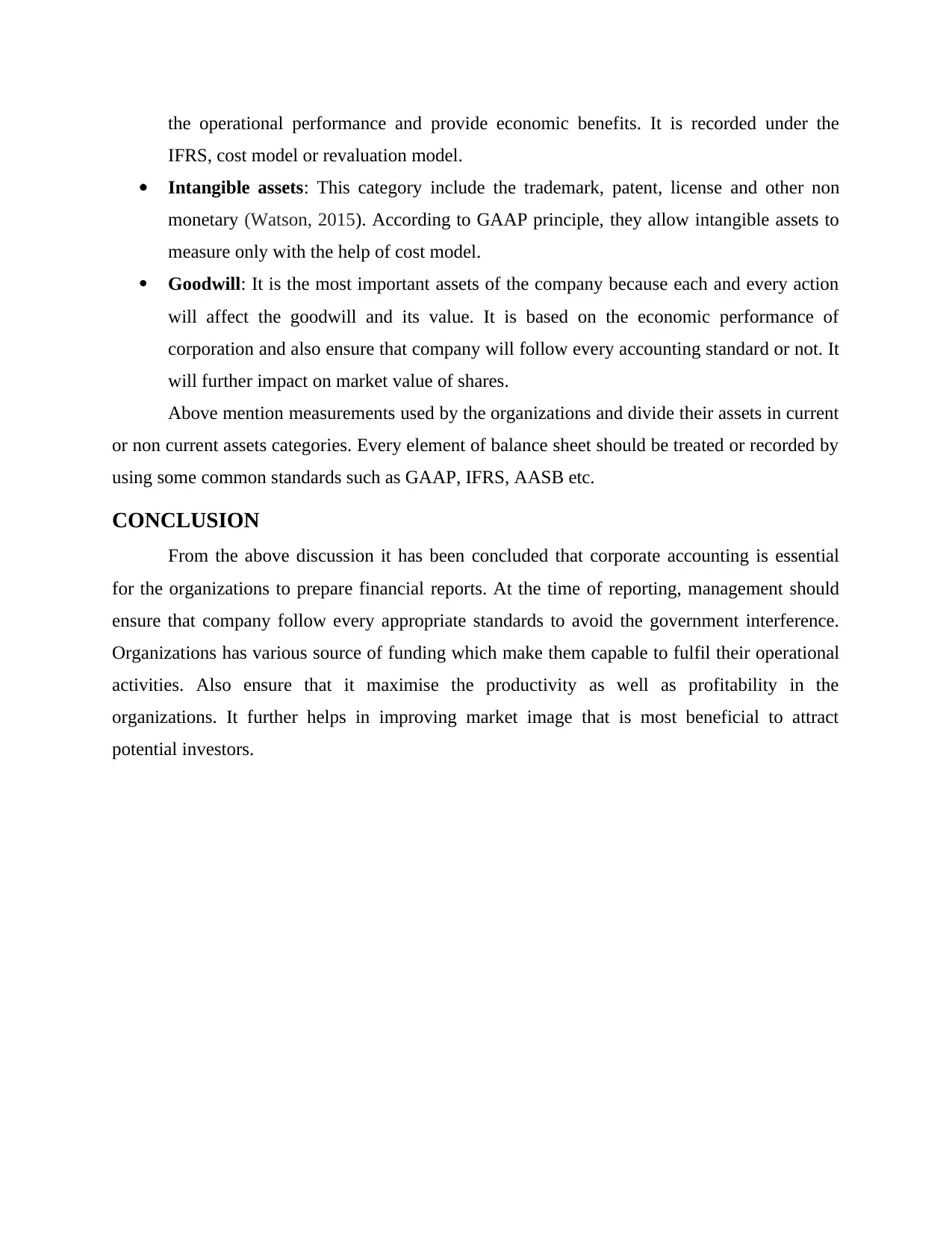
the operational performance and provide economic benefits. It is recorded under the
IFRS, cost model or revaluation model.
Intangible assets: This category include the trademark, patent, license and other non
monetary (Watson, 2015). According to GAAP principle, they allow intangible assets to
measure only with the help of cost model.
Goodwill: It is the most important assets of the company because each and every action
will affect the goodwill and its value. It is based on the economic performance of
corporation and also ensure that company will follow every accounting standard or not. It
will further impact on market value of shares.
Above mention measurements used by the organizations and divide their assets in current
or non current assets categories. Every element of balance sheet should be treated or recorded by
using some common standards such as GAAP, IFRS, AASB etc.
CONCLUSION
From the above discussion it has been concluded that corporate accounting is essential
for the organizations to prepare financial reports. At the time of reporting, management should
ensure that company follow every appropriate standards to avoid the government interference.
Organizations has various source of funding which make them capable to fulfil their operational
activities. Also ensure that it maximise the productivity as well as profitability in the
organizations. It further helps in improving market image that is most beneficial to attract
potential investors.
IFRS, cost model or revaluation model.
Intangible assets: This category include the trademark, patent, license and other non
monetary (Watson, 2015). According to GAAP principle, they allow intangible assets to
measure only with the help of cost model.
Goodwill: It is the most important assets of the company because each and every action
will affect the goodwill and its value. It is based on the economic performance of
corporation and also ensure that company will follow every accounting standard or not. It
will further impact on market value of shares.
Above mention measurements used by the organizations and divide their assets in current
or non current assets categories. Every element of balance sheet should be treated or recorded by
using some common standards such as GAAP, IFRS, AASB etc.
CONCLUSION
From the above discussion it has been concluded that corporate accounting is essential
for the organizations to prepare financial reports. At the time of reporting, management should
ensure that company follow every appropriate standards to avoid the government interference.
Organizations has various source of funding which make them capable to fulfil their operational
activities. Also ensure that it maximise the productivity as well as profitability in the
organizations. It further helps in improving market image that is most beneficial to attract
potential investors.
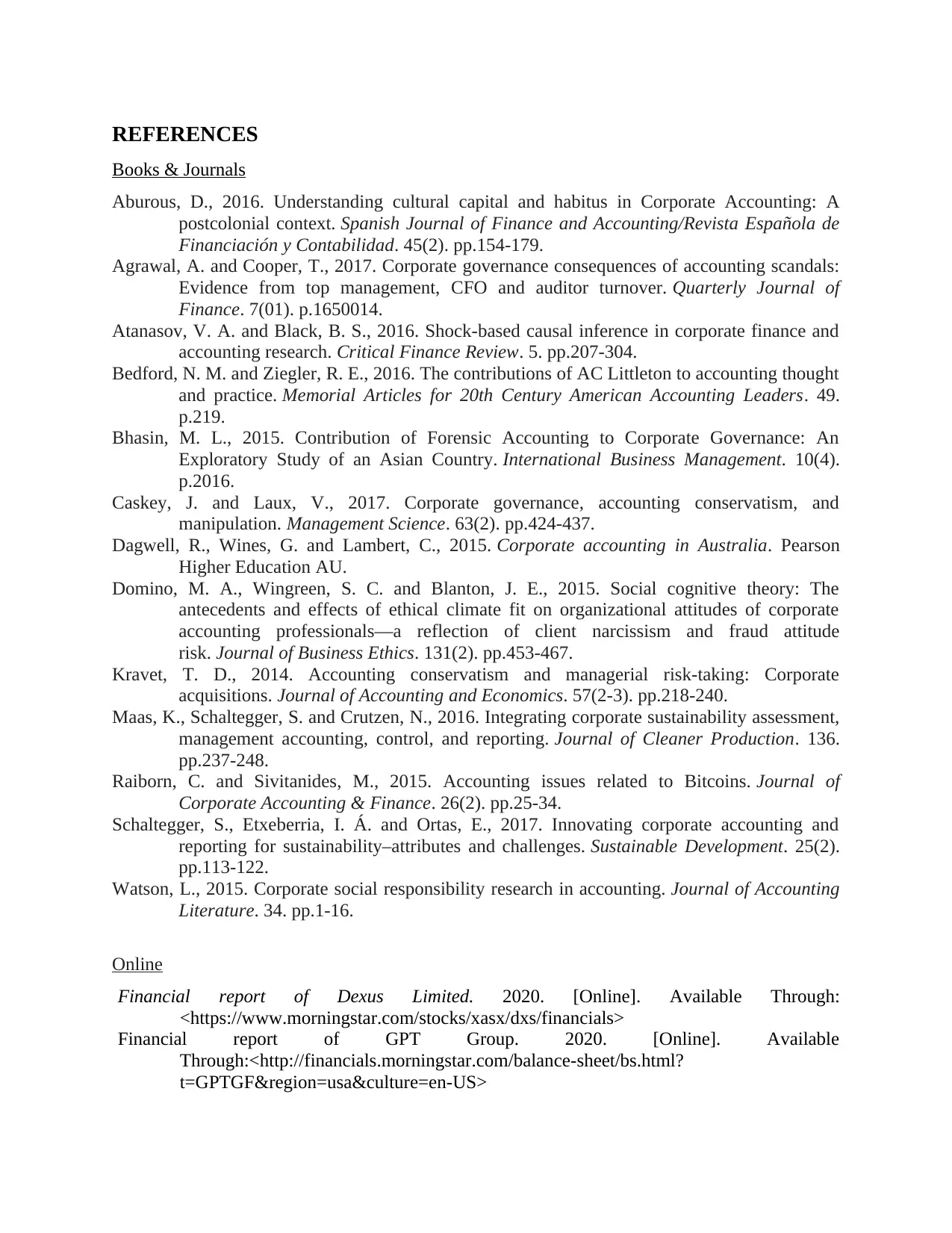
REFERENCES
Books & Journals
Aburous, D., 2016. Understanding cultural capital and habitus in Corporate Accounting: A
postcolonial context. Spanish Journal of Finance and Accounting/Revista Española de
Financiación y Contabilidad. 45(2). pp.154-179.
Agrawal, A. and Cooper, T., 2017. Corporate governance consequences of accounting scandals:
Evidence from top management, CFO and auditor turnover. Quarterly Journal of
Finance. 7(01). p.1650014.
Atanasov, V. A. and Black, B. S., 2016. Shock-based causal inference in corporate finance and
accounting research. Critical Finance Review. 5. pp.207-304.
Bedford, N. M. and Ziegler, R. E., 2016. The contributions of AC Littleton to accounting thought
and practice. Memorial Articles for 20th Century American Accounting Leaders. 49.
p.219.
Bhasin, M. L., 2015. Contribution of Forensic Accounting to Corporate Governance: An
Exploratory Study of an Asian Country. International Business Management. 10(4).
p.2016.
Caskey, J. and Laux, V., 2017. Corporate governance, accounting conservatism, and
manipulation. Management Science. 63(2). pp.424-437.
Dagwell, R., Wines, G. and Lambert, C., 2015. Corporate accounting in Australia. Pearson
Higher Education AU.
Domino, M. A., Wingreen, S. C. and Blanton, J. E., 2015. Social cognitive theory: The
antecedents and effects of ethical climate fit on organizational attitudes of corporate
accounting professionals—a reflection of client narcissism and fraud attitude
risk. Journal of Business Ethics. 131(2). pp.453-467.
Kravet, T. D., 2014. Accounting conservatism and managerial risk-taking: Corporate
acquisitions. Journal of Accounting and Economics. 57(2-3). pp.218-240.
Maas, K., Schaltegger, S. and Crutzen, N., 2016. Integrating corporate sustainability assessment,
management accounting, control, and reporting. Journal of Cleaner Production. 136.
pp.237-248.
Raiborn, C. and Sivitanides, M., 2015. Accounting issues related to Bitcoins. Journal of
Corporate Accounting & Finance. 26(2). pp.25-34.
Schaltegger, S., Etxeberria, I. Á. and Ortas, E., 2017. Innovating corporate accounting and
reporting for sustainability–attributes and challenges. Sustainable Development. 25(2).
pp.113-122.
Watson, L., 2015. Corporate social responsibility research in accounting. Journal of Accounting
Literature. 34. pp.1-16.
Online
Financial report of Dexus Limited. 2020. [Online]. Available Through:
<https://www.morningstar.com/stocks/xasx/dxs/financials>
Financial report of GPT Group. 2020. [Online]. Available
Through:<http://financials.morningstar.com/balance-sheet/bs.html?
t=GPTGF®ion=usa&culture=en-US>
Books & Journals
Aburous, D., 2016. Understanding cultural capital and habitus in Corporate Accounting: A
postcolonial context. Spanish Journal of Finance and Accounting/Revista Española de
Financiación y Contabilidad. 45(2). pp.154-179.
Agrawal, A. and Cooper, T., 2017. Corporate governance consequences of accounting scandals:
Evidence from top management, CFO and auditor turnover. Quarterly Journal of
Finance. 7(01). p.1650014.
Atanasov, V. A. and Black, B. S., 2016. Shock-based causal inference in corporate finance and
accounting research. Critical Finance Review. 5. pp.207-304.
Bedford, N. M. and Ziegler, R. E., 2016. The contributions of AC Littleton to accounting thought
and practice. Memorial Articles for 20th Century American Accounting Leaders. 49.
p.219.
Bhasin, M. L., 2015. Contribution of Forensic Accounting to Corporate Governance: An
Exploratory Study of an Asian Country. International Business Management. 10(4).
p.2016.
Caskey, J. and Laux, V., 2017. Corporate governance, accounting conservatism, and
manipulation. Management Science. 63(2). pp.424-437.
Dagwell, R., Wines, G. and Lambert, C., 2015. Corporate accounting in Australia. Pearson
Higher Education AU.
Domino, M. A., Wingreen, S. C. and Blanton, J. E., 2015. Social cognitive theory: The
antecedents and effects of ethical climate fit on organizational attitudes of corporate
accounting professionals—a reflection of client narcissism and fraud attitude
risk. Journal of Business Ethics. 131(2). pp.453-467.
Kravet, T. D., 2014. Accounting conservatism and managerial risk-taking: Corporate
acquisitions. Journal of Accounting and Economics. 57(2-3). pp.218-240.
Maas, K., Schaltegger, S. and Crutzen, N., 2016. Integrating corporate sustainability assessment,
management accounting, control, and reporting. Journal of Cleaner Production. 136.
pp.237-248.
Raiborn, C. and Sivitanides, M., 2015. Accounting issues related to Bitcoins. Journal of
Corporate Accounting & Finance. 26(2). pp.25-34.
Schaltegger, S., Etxeberria, I. Á. and Ortas, E., 2017. Innovating corporate accounting and
reporting for sustainability–attributes and challenges. Sustainable Development. 25(2).
pp.113-122.
Watson, L., 2015. Corporate social responsibility research in accounting. Journal of Accounting
Literature. 34. pp.1-16.
Online
Financial report of Dexus Limited. 2020. [Online]. Available Through:
<https://www.morningstar.com/stocks/xasx/dxs/financials>
Financial report of GPT Group. 2020. [Online]. Available
Through:<http://financials.morningstar.com/balance-sheet/bs.html?
t=GPTGF®ion=usa&culture=en-US>
1 out of 13
Related Documents
Your All-in-One AI-Powered Toolkit for Academic Success.
+13062052269
info@desklib.com
Available 24*7 on WhatsApp / Email
![[object Object]](/_next/static/media/star-bottom.7253800d.svg)
Unlock your academic potential
© 2024 | Zucol Services PVT LTD | All rights reserved.





